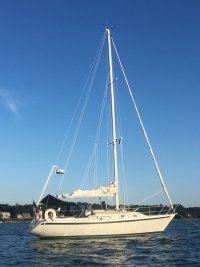I need to drill and tap some bolts into my mast to install cheek blocks for lazy jacks. I will be drilling into the mast about 6 feet above the lower spreaders on each side of the mast. Question:is there any wiring conduit inside the mast that I nee to avoid or are all the wires and halyards all just hangin loose? I can be careful not to drill much pas the material of the mast, but still worried. Thanks, Elrod
P.S. laid out the lazy jacks on my driveway to check best layout. Seemed like 6ft above lower spreader was about right for blocks. Anyone have thoughts on that?
P.S. laid out the lazy jacks on my driveway to check best layout. Seemed like 6ft above lower spreader was about right for blocks. Anyone have thoughts on that?

